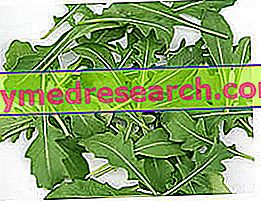
The rocket ( Eruca sativa Miller) is an annual herbaceous plant belonging to the Brassicaceae family (cruciferous). The rocket recognizes numerous uses, both in the culinary and in the medical / herbalist fields.

We must be very careful not to confuse the classic rocket with a very similar plant, which is the wild rocket ( Diplotaxis tenuifolia (L.) DC.). The latter, unlike Eruca sativa, has mostly serrated leaves, yellow flowers and a much stronger and spicy taste.
History of Rucola
The rocket has a very ancient history. Already in Roman times, it was used as a flavoring ingredient for foods, but also as a supposed aphrodisiac substance.
Rocket cultivation has developed throughout the Mediterranean area and in central-western Asia. Nowadays, it is abundantly cultivated in Veneto, but also in northern Europe, in North America and in India. In the latter locality, the seeds of the plant are known as Gargeer.
Plant morphology
The sativa rocket, if left to grow, can reach up to 50 centimeters in height. The leaves, supported by small glabrous stems gathered at the base (rosette), are green, with serrated edges, oblong (similar to a spear), characteristic odor and a more or less spicy taste.

The flavor of the rocket is mainly influenced by the type of soil and the season. The more arid the soil and the late harvest, the greater the intensity of the flavor.
The flowers of the rocket are formed by four petals, with a white-yellowish or violet color, whose flowering takes place from February to June. The fruits of the rocket are siliques, which in turn contain a variable number of small edible seeds.
The rocket is grown up to an altitude of about 800-1000 meters above sea level; it grows well on any type of soil, preferably limestone and arid (it is very sensitive to water stagnation). Sowing takes place in spring, and then continues into winter. In the latter case it is necessary to have the foresight to cover the seeds with some soil.
The rocket leaves can be harvested throughout the year, especially if they are well developed and without flowers.
The leaves and roots are the most used parts. The first can be used both fresh and frozen, while the roots are dried.
Rocket: nutritional aspects

Rocket: health aspects
The health aspects of rocket are largely beneficial for our body:
- presence of vitamin C. In past times it was used to fight scurvy;
- presence of potassium, iron, calcium and phosphorus;
- stimulates the appetite;
- promotes digestion;
- diuretic action;
- bechic action;
- beneficial for the liver;
- carminative action, promotes the expulsion of intestinal gases;
- stimulates the organism in the period of convalescence and weakness;
- soothing and invigorating action when taken as herbal tea with mint and savory flowered tops.
The only negative aspect of the rocket relates to the ease with which it causes irritating effects on our body when taken in high doses.
Rucola: uses in the kitchen
Rocket, like wild rocket, is widely used in the kitchen. If you want to give the dish an intense flavor with a hint of spiciness, the wild rocket is certainly more suitable. Still in the culinary field, the rocket is marrying with vegetables, meats, dairy products, sweet corn, pizza, pasta and many other foods.
A tip for all cooking enthusiasts is to try to season the pasta with a kind of pesto alla genovese based on rocket. The seasoning is obtained following the classic recipe for the pesto alla genovese, only that the basil is replaced, in whole or in part, with the rocket leaves.
Rocket Pesto
X Problems with video playback? Reload from YouTube Go to Video Page Go to Video Recipes Section Watch the video on youtubeCuriosity
On the island of Ischia, a rocket-based liqueur is prepared called Rucolino . Usually this liqueur, together with the infamous limoncello, is served after meals to facilitate digestion. Another curiosity is that the rocket is widely used in Egypt as a side dish to fish dishes.



